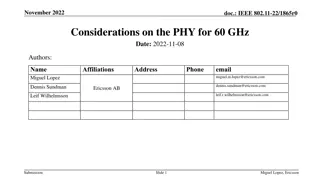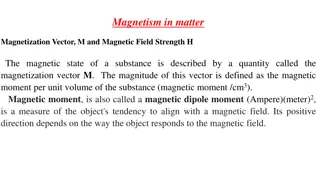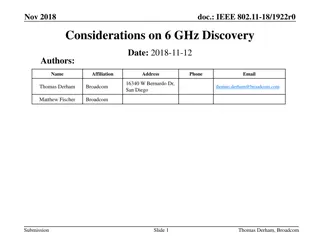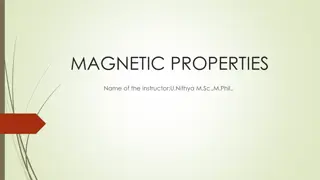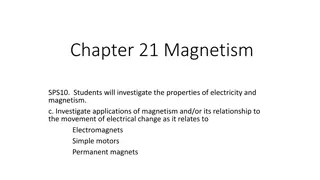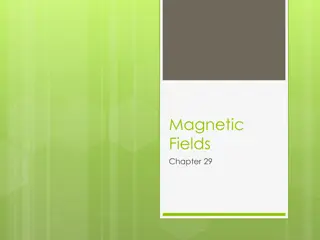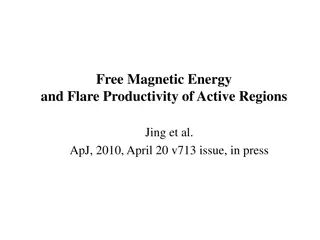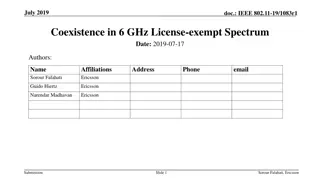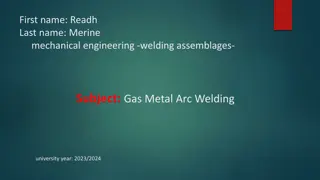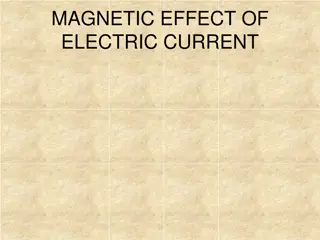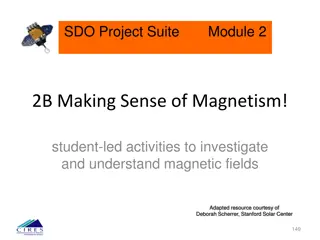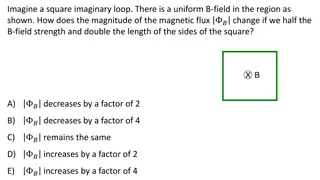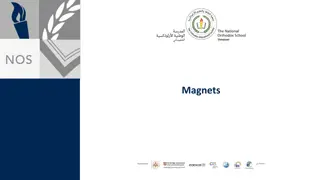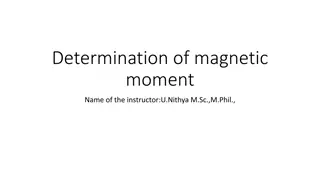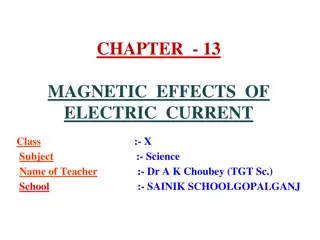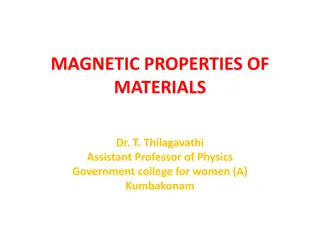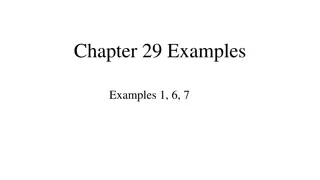Understanding Magnetic Shielding Considerations for 3.9 GHz Cavities
This document discusses Q and magnetic shielding considerations for 3.9 GHz cavities used in the LCLS-II project, highlighting the unique behavior observed in nitrogen-treated cavities. The study delves into the improved Q values and field dependence of quality factors, challenging traditional niobium cavity behaviors. Analysis of BCS resistance, residual resistance, and material removal post nitrogen treatment sheds light on achieving optimal cavity performance at higher fields.
Download Presentation

Please find below an Image/Link to download the presentation.
The content on the website is provided AS IS for your information and personal use only. It may not be sold, licensed, or shared on other websites without obtaining consent from the author. Download presentation by click this link. If you encounter any issues during the download, it is possible that the publisher has removed the file from their server.
E N D
Presentation Transcript
Q and magnetic shielding considerations for 3.9 GHz cavities for LCLS-2 Anna Grassellino 3.9 GHz PDR 20 November 2015
Cavity gradient and Q0 requirements (recent data from XFEL cavity production) 10000 before 150C after 150C Expon. (before 150C) Expon. (after 150C) 1000 R. nOhm 100 P.Perini, INFN 10 2.5 3 3.5 4 4.5 5 Tc/T Recent XFEL production cavities (INFN LASA-Zanon); With BCP treatment, at 2K the all cavities have Qo in range ~(2- 3) 109 No field slope up-to ~17 MV/m; Quench at 20-23 MV/m, VTS No Q degradation after welding to HV N.Solyak 3
Two main things in these curves are striking: 1) the measured Q values at T = 2 K are significantly higher than typical values for standardly treated surfaces; 2) the field dependence of the quality factor is reversed, showing an extended anti-Q-slope, contrary to the standard medium Q-slope behavior of niobium cavities. The medium field Q-slope in Nb cavities after standard surface treatments is due to the increase in both residual resistance and BCS resistance with the amplitude of the RF field, as it has been recently shown in [31]. To gain a better understanding of the origin of the Q improvement in the nitrogen treated cavities, we adopted the same technique for decoupling residual resistance and BCS resistance as a function of field as described in [31]. The results are shown in Fig. 2 in comparison to the standard cavity surface treatments: EP, BCP, before and after the 120 C bake. Such an analysis reveals that the nitrogen treatment decreases the BCS resistance at low RF fields to values comparable to those obtained with the 120 C bake. However, as the field increases, the BCS resistance increases dramatically Q expectations scaling from 1.3 GHz to 3.9 GHz for the 120 C case, whereas it actually decreases even further for the nitrogen treatment case. This strong difference leads to a BCS resistance ~2.5 times lower compared to the 120 C treatment and ~3.5 times lower compared to standard EP or BCP. An unusual and extended anti Q-slope therefore stems from this inverted field dependence of the BCS resistance. All four cavities were also associated with lower than typical residual resistance values, as shown for example in Fig. 2. ! Figure 2. Temperature-dependent (BCS) and temperature independent (residual) components of the microwave surface resistance. A comparison is shown for the nitrogen treated cavities and those after standard treatments including EP, BCP and 120 C bake. Additional studies were performed on the microwave surface resistance evolution as a function of material removal post nitrogen treatment. In Fig. 3 we show the evolution of the Q(Eacc) curves of the three different fine grain cavities for different amount of material removal via EP. For TE1AES005 it is revealing to notice how the Q-curve changes: for 20 and 40 m removal the low field Q is high compared to that of standard EP surfaces, but the medium field Q-slope still dominates the curve. However, with further 40 m removal (80 m total removal post nitrogen), an extended anti Q-slope appears, indicating that there is an optimal amount of material removal post nitrogen treatment, which gives the high Q performance up to the higher fields. For the cavity TE1NR005 the anti- Q-slope is already found with just 5 m removal, and interestingly 4 !
Q expectations scaling from 1.3 GHz to 3.9 GHz matches measurements BCP: Rs(2K, ~90 mT) ~ 12 to 14 (BCS) + 4 to 8 (residual) nanoOhm @ 1.3GHz --> [108 to 126] + [7 to 14] ~ 115-140 nOhm @ 3.9 GHz --> Q(3.9 GHz, 2K, 16)~ 2e9 to 2.5e9 BCP +120C bake : Rs(2K, ~90 mT) ~ 8 to 10 (BCS) + 4 to 8 (residual) nanoOhm @ 1.3GHz --> [72 to 90] + [7 to 14] ~ 79 to 104 nOhm @ 3.9 GHz --> Q(3.9 GHz, 2K, 16) ~ 2.6e9 to 3.5e9 N doping + EP: Rs(2K, ~90 mT) ~ 4 (BCS) + 1 to 3 (residual) nanoOhm @ 1.3GHz --> 36 + [2-5] ~ 38 to 43 nOhm @ 3. GHz --> Q(3.9GHz, 2K, 16) ~ 6 to 7e9 5
RF Surface Resistance breakdown and budget for RFL Very small budget for trapped magnetic flux induced residual resistance Q dominated by BCS already at limit of specs with BCP only Q should benefit from 120C bake as it reduces BCS surface resistance, and pushes onset of HFQS to higher gradients Cavity treatment Q0 (17 MV/m, 2K) R0 (17 MV/m) [n ] ~14 RBCS (17 MV/m,2K) [n ] RFL (17 MV/m) max [n ] BCP 2 2.5e9 ~126 <5 BCP + 120 C bake 2.6 3.5e9 ~14 ~90 ~30 Maximum allowable extra trapped flux induced residual to meet 2e9 specification 6 Anna Grassellino | High Q 650 MHz November 9, 2015
Therefore, remnant magnetic field spec in CM To meet 2e9 attention has to be paid to remnant field in CM Model below assumes full flux trapping Seems very promising for BCP+120C bake Cavity treatment Sensitivity @ 17MV/m [n /mGauss] 1.2 RFL (17 MV/m) max [n ] BMAX-CM [mGauss] BCP 5 ~4 BCP + 120C bake 0.87 30 ~34 Maximum allowable magnetic field in cryomodule to meet 2e9 specification Scaled with square root of frequency measurements from: Martinello et al, Proceedings of SRF 2015, MOPB015 7 Anna Grassellino | High Q 650 MHz November 9, 2015
Expected magnetic field for 3.9 GHz cryomodules? For 1.3 GHz, without active cancellation B ~ 15-20 mGauss For 3.9 GHz may be a bit worse as size of openings in the shielding will matter more relatively to the smaller sized cavity Consider magnetic shielding inside vessel? LCLS-II Spec. LCLS-II Spec. Without active cancellation (FEM calc.) we expect Bavg ~ 15-20 mG With active cancellation (FEM calc.) we expect Bavg < 3 mG [2] A. Crawford, arxiv.org/ftp/arxiv/papers/1507/1507.06582.pdf. [5] The Conceptual Design Report for the TeSLA Test Facility Linac, Version 1, 1995. [6] T. Bitter et al., Nucl. Instrum. Methods A, 309, 1991. 8 S.K. Chandrasekaran | LCLS-II Vacuum Vessel Degaussing & B Cancellation Coils 10/1/2015
Need to cool down fast through Tc to expel magnetic flux efficiently 4.0x1010 3.8x1010 3.6x1010 3.4x1010 Dressed 1.3 GHz N doped nine cell cavity vertical test at T=2K Effect less severe at 650 but still important 3.2x1010 3.0x1010 2.8x1010 2.6x1010 #1: First fast from 300K #2: Slow from 15K #3: Fast from 15K Q0 2.4x1010 2.2x1010 2.0x1010 1.8x1010 1.6x1010 1.4x1010 1.2x1010 1.0x1010 0 5 10 15 20 25 Eacc (MV/m) A. Romanenko, A. Grassellino, O. Melnychuk, D. A. Sergatskov, J. Appl. Phys. 115, 184903 (2014) A. Romanenko, A. Grassellino, A.Crawford, D. A. Sergatskov, Appl. Phys. Lett. 105, 234103(2014) D. Gonnella et al, J. Appl. Phys. 117, 023908 (2015) M. Martinello, M. Checchin, A. Grassellino, A. Romanenko, A. Crawford, D. A. Sergatskov, O. Melnychuk, J. Appl. Phys. 118, 044505 (2015) A. Grassellino - Director s Review, Oct 20-22 2015 9
Efficient flux expulsion cooling AND the right amount of annealing needed S. Posen et al, http://arxiv.org/pdf/1509.03957v2.pdf 10 Anna Grassellino | High Q 650 MHz November 9, 2015


